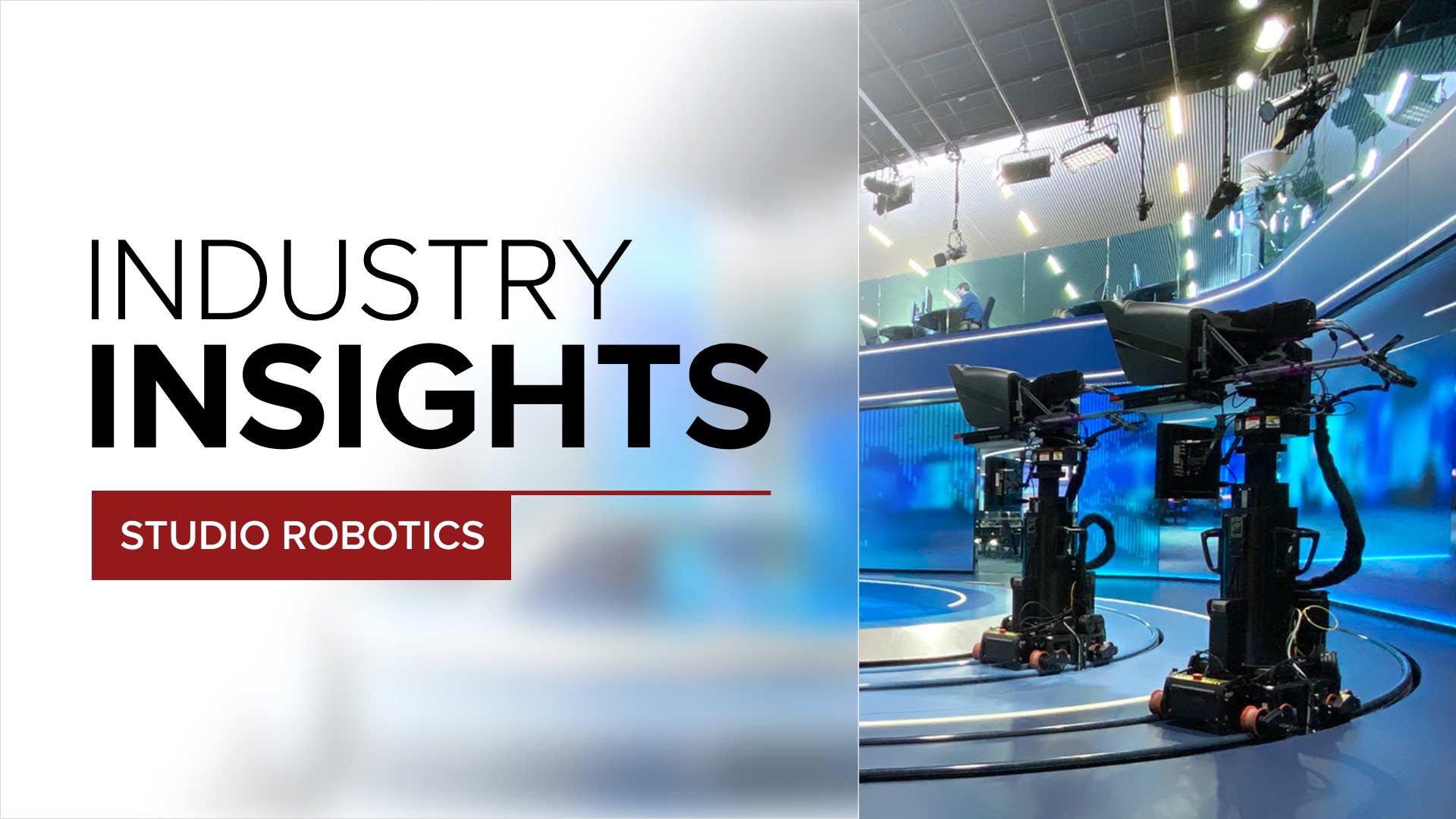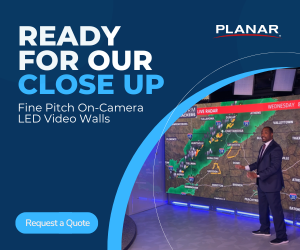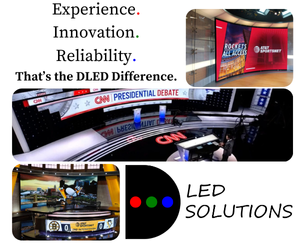Industry Insights: Studio camera robotics and production workflows

Weekly insights on the technology, production and business decisions shaping media and broadcast. Free to access. Independent coverage. Unsubscribe anytime.
Last year saw an immediate shift in many broadcasters’ studio workflow due to the COVID-19 pandemic. This spring, we’ll be looking at how the lessons from work from home and reduced staffing will impact future productions in our latest Industry Insights roundtable series.
Up first is a conversation about broadcast studio robotics which has been a rise in interest due to the events of 2020.
Make sure to read the rest of our Industry Insights series, including:
- The future of camera control and automation
- IP production, automation, cameras, and cutting-edge trends
How does working from home impact camera control and studio robotics? More specifically, how is it impacting your products?
“If there is something we’ve learned over the past year as productions have been forced to move from studios to remote and work-from-home environments, it’s that broadcasters need tools that are cost-effective, work seamlessly together and are easy for one person to operate,” said Bob Caniglia, director of sales operations for Blackmagic Design.
“The biggest immediate impact has been an increased interest in robotic camera systems where working from home precludes manual operation,” said Vinten’s product manager, Neil Gardner.
“Customers are looking for simplified ways of controlling their studio robotics so that they can allow their (many) operators to control them from home. They can’t afford to purchase expensive proprietary control systems for each operator to take home with them, so they need solutions that can either be virtualized or that are entirely or primarily software-based that can be downloaded and installed at the operator’s home,” said Karen Walker, VP of camera motion systems at Ross Video.
“This is where our DashBoard control system fits in perfectly. A free download that includes control of pan, tilt, zoom, and focus from any PC, Mac or Linux computer, it can be paired with a USB joystick to provide control of our robotics from anywhere on the network. As long as they can get a connection to the studio network where the robotics reside, they can recall, update, and create presets and moves, trim or bump shots with either the onscreen joystick or something as common as an Xbox controller. This is an ideal solution to reduce the number of people in studios yet still provides the skilled camera operators with full access to provide the quality expected,” added Walker.
“One way we’ve addressed our customers’ needs is with the free Blackmagic Camera Update 6.9 for our Pocket Cinema Camera 4K and Pocket Cinema Camera 6K models. It adds studio camera features, such as control of the camera parameters, lens and tally light, so our customers can easily use the cameras with our ATEM Mini line of live production switchers for a powerful live production and streaming setup from home. Studio camera remote control, along with a built-in DaVinci Resolve color corrector, provides our customers with even more creative options for their productions,” said Caniglia.
“Our systems were designed to support remote operation using the included LogMeIn software. Because we support highly visual named and saved presets, and monitor Preview, Program and all camera inputs on the user interface, working remotely is very effective. So there has actually been an increase in product interest over the last year,” explained the president of Rushworks, Rush Beesley.
“Studio robotics allow for fewer people to be on the studio floor, and in many cases in different locations completely – even in different cities or countries. This highlights the importance of good connectivity , and having camera control systems that support standard communication infrastructure rather than bespoke connections. Vinten robotics have been designed for, and capable of, remote operation for many years and therefore the product impact has been minimal – it’s more a case of business as usual, but with more extensive demand for geographically diverse access,” said Gardner.
“Robotic cameras, by definition, make remote control possible. A single operator, located anywhere there is a simple network and video connection, can control multiple cameras and studios. It’s particularly easy with our systems because we have always focused on keeping network dependency to a minimum and intelligence close to the robotic camera itself,” said James Eddershaw, managing director at Shotoku Broadcast Systems.
“People working from home want tools that are intuitive and easy to set up. It’s created new demand for our products because instead of having to work from a TV studio, customers now need to work from home with many of the same capabilities they had before. Telemetrics has always developed robotic camera control products that can be controlled locally or remotely. We are doing a lot of ‘studio in a cart’ projects for both large and small broadcasters and further expanding this solution is a high priority for us,” answered Michael Cuomo, VP at Telemetrics.
How are workflows being optimized or changed based on lessons learned during work-from-home?
“When the transition to working from home first began, many workflows were cobbled together to quickly get up and running. As time has passed, broadcasters have realized that they need long term solutions that support their optimal workflows, rather than patching gear together and being forced into a less than ideal one,” said Caniglia.
“With work-from-home, everyone has had to learn how to do their job differently. From anchors having to manage their home studio by themselves to single operators in the control room, workflows have completely changed,” said Cuomo.
“This has increased the necessity for tools like robotics and AI to automate or allow people to do their jobs at a safe distance. A lot of these workflows were already in place, but were underutilized, so work-from-home has taught us that we can be successful in this environment,” Cuomo added.
“Our current workflows are all IP-based and the importance of this is being recognized. The ability to have remote access to control robots in different locations is now being highlighted as an important requirement in requests and tenders we are seeing. Also, we’re seeing the need for improved integration into other systems which is where the ability of Ross to provide a complete ecosystem of solutions is increasingly important. There’s also the continuing trend towards less ‘people interaction’ with products – less physical contact with products and greater automation in order to keep people and work/control surfaces safe,” answered Walker.
“We’ve seen investment in purpose-built technology that’s made to support remote workflows and collaboration. It’s been our goal to help facilitate remote workflows and make it easy for our customers to create professional multi-camera live streams and productions, regardless of ability or budget,” said Caniglia.
“We provide assistance with integrating remote meeting solutions into our workflow. Using Zoom and similar platforms, the biggest challenge is to eliminate audio looping feedback in the system. Using inexpensive methods we’re able to solve those issues and ensure effective ‘hybrid’ meeting production (in-room attendees and remote participants),” said Beesley.
“The most interesting development has been to explore how to enable the presenter or talent to more easily control their own equipment, and reduce the reliance on someone remotely controlling the system 24/7, where this isn’t practical. In the short term this has resulted in providing ways to extending basic control of the camera to within arm’s reach of the presenter, and is ultimately going to result in systems that become more autonomous for simple ‘to camera’ presentations from home, or other remote locations,” said Gardner.
“Use of even more automation helps to enable staff who are not in the building to prepare and configure as much as possible offline,” Eddershaw noted.
How has reduced staffing in studios changed the need for studio robotics?
“Reduced staffing in studios is a driver for robotic camera systems at any time. The added pressure today makes robotics even more important and often critical to the ability to continue live productions with virtually no staff in the building,” explained Eddershaw.
“With reduced staffing, robotics are essential to reposition the cameras and also provide smooth on-air moves. Our OmniGlide is a great product for this because it achieves both these goals. When used in tandem with our RCCP-2A Studio Control System, operators can see where the cameras are in real-time in a 3D model of their studio,” said Cuomo.
“This has had a big impact – particularly in markets that not traditionally been big users of camera robotics. We’re seeing television shows, sporting events, corporate customers all looking to introduce robotics to reduce the number of personnel in the venue or studio. Some of the really interesting feedback has been that customers are actually able to do some things better with robotics because they take up less space, they can provide some different creative looks and they can still get all the shots they were accustomed to before,” said Walker.
“By definition, robotics implies an ability to reduce staffing requirements. So the need for these devices has certainly increased in order to maintain, sustain and even improve production efficiency and quality with many fewer on-site resources,” Beesley said.
“We are seeing significant interest in different geographies and regions that have not traditionally strong robotic users, the driver being the reduced number of people in the same space. So we’re anticipating that we’re going to see these applications continue – especially as it looks like we’re still going to be dealing with these (socially distant) conditions for a while yet,” Walker added.
“In many ways the necessity for a significant number of people to work from home during the pandemic has reinforced the benefits of remote camera control. Where production is broadcast from a studio, it provides an ideal solution for reducing the number of people who need to be in the studio or travel to the workplace. Where a studio needs to be bypassed, it allows cameras to be located at the presenter’s home and to be operated by people in other locations,” said Gardner.
Participants
Bob Caniglia – Blackmagic Design
Karen Walker – Ross Video
Rush Beesley – Rushworks
Neil Gardner – Vinten
James Eddershaw – Shotoku Broadcast Systems
Michael Cuomo – Telemetrics





tags
Blackmagic Design, Bob Caniglia, Coronavirus, James Eddershaw, Karen Walker, Michael Cuomo, Neil Gardner, Robotic Camera Control, robotic cameras, Ross Video, Rush Beesley, Rushworks, Shotoku Broadcast Systems, Telemetrics, Telemetrics OmniGlide, TV Studio Cameras, Vinten
categories
Broadcast Engineering, Broadcast Equipment, Camera Control & Camera Robotics, Cameras, Featured, Industry Insights, News and Entertainment Production Systems, Studio Technology, Voices